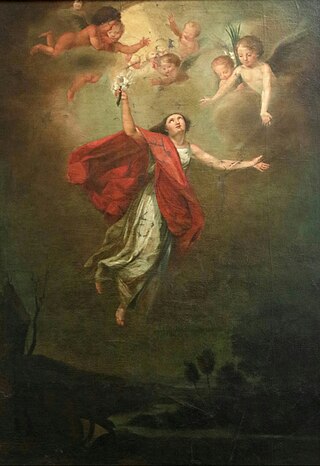
Agnes of Rome is a virgin martyr, venerated as a saint in the Catholic Church, Oriental Orthodox Church and the Eastern Orthodox Church, as well as the Anglican Communion and Lutheran Churches. She is one of several virgin martyrs commemorated by name in the Canon of the Mass, and one of many Christians martyred during the reign of the Roman emperor Diocletian.

Philomena, also known as Saint Philomena or Philomena of Rome was a virgin martyr whose remains were discovered on May 24–25, 1802, in the Catacomb of Priscilla. Three tiles enclosing the tomb bore an inscription, Pax Tecum Filumena, that was taken to indicate that her name was Filumena, the English form of which is Philomena. Philomena is the patron saint of infants, babies, and youth, and is known as "The Wonderworker".

Margaret, known as Margaret of Antioch in the West, and as Saint Marina the Great Martyr in the East, is celebrated as a saint on 20 July in Western Christianity, on 30th of July by the Eastern Orthodox Church, and on Epip 23 and Hathor 23 in the Coptic Orthodox Church. She was reputed to have promised very powerful indulgences to those who wrote or read her life or invoked her intercessions; these no doubt helped the spread of her following. Margaret is one of the Fourteen Holy Helpers and is one of the saints with whom Joan of Arc claimed to have spoken.

Ursula was a Romano-British virgin and martyr possibly of royal origin. She is venerated as a saint in the Roman Catholic Church, Eastern Orthodox Church and the Anglican Communion. Her feast day in the pre-1970 General Roman Calendar and in some regional calendars of the ordinary form of the Roman Rite is 21 October.

Saints Faith, Hope, and Charity , are a group of Christian martyred saints who are venerated together with their mother, Sophia ("Wisdom").

May 30 - Eastern Orthodox Church calendar - June 1

July 31 - Eastern Orthodox liturgical calendar - Aug. 2

August 10 - Eastern Orthodox liturgical calendar - August 12

August 12 - Eastern Orthodox liturgical calendar - August 14

Sant'Agnese in Agone is a 17th-century Baroque church in Rome, Italy. It faces onto the Piazza Navona, one of the main urban spaces in the historic centre of the city and the site where the Early Christian Saint Agnes was martyred in the ancient Stadium of Domitian. Construction began in 1652 under the architects Girolamo Rainaldi and his son Carlo Rainaldi. After numerous quarrels, the other main architect involved was Francesco Borromini.

December 31 - Eastern Orthodox liturgical calendar - January 2

January 22 - Eastern Orthodox liturgical calendar - January 24

Martinian and Processus were Christian martyrs of ancient Rome. Neither the years they lived nor the circumstances of their deaths are known. They are currently buried in St. Peter's Basilica in Rome.

Mark and Marcellian are martyrs venerated as saints by the Roman Catholic Church and the Eastern Orthodox Church. Their cult is sometimes associated with that of Saints Tranquillinus, Martia, Nicostratus, Zoe, Castulus, and Tiburtius, though not in the official liturgical books of the Church, which mention only Mark and Marcellianus among the saints for 18 June. Their mention in the General Roman Calendar on that date from before the time of the Tridentine calendar was removed in the 1969 revision, because nothing is known about them except their names, the fact of their martyrdom, and that they were buried on 18 June in the cemetery of Santa Balbina on the Via Ardeatina.
Flavia Domitilla was a Roman noblewoman of the 1st century AD. She was a granddaughter of Emperor Vespasian and a niece of Emperors Titus and Domitian. She married her second cousin, the consul Titus Flavius Clemens, a grand-nephew of Vespasian through his father Titus Flavius Sabinus.

Petronilla is an early Christian saint. She is venerated as a virgin by the Catholic Church. She died in Rome at the end of the 1st century, or possibly in the 3rd century.
Rictius Varus was a Vicarius in Roman Gaul at the end of the 3rd century, around the time of the Diocletianic Persecution. The Roman Martyrology contains many references to the prefect Rixius Varus, who is said to have persecuted hundreds of Christians. In Christian hagiography he later repented and became a Christian martyr himself, and is regarded a Saint in the Eastern Orthodox and Roman Catholic Churches, with his feast day on July 6.

Christina of Tyre, also known as Christine of Bolsena, or in the Eastern Orthodox Church as Christina the Great martyr, is venerated as a virgin martyr of the third century. Archaeological excavations of an underground cemetery constructed over her tomb have shown that she was venerated at Tyre by the fourth century.

Christina, born Yazdoi, was a Sasanian Persian noblewoman and Christian venerated after her death as a virgin martyr.

Stephen is traditionally venerated as the protomartyr or first martyr of Christianity. According to the Acts of the Apostles, he was a deacon in the early church at Jerusalem who angered members of various synagogues by his teachings. Accused of blasphemy at his trial, he made a speech denouncing the Jewish authorities who were sitting in judgment on him and was then stoned to death. Saul of Tarsus, later known as Paul the Apostle, a Pharisee and Roman citizen who would later become an apostle, participated in Stephen's execution.














